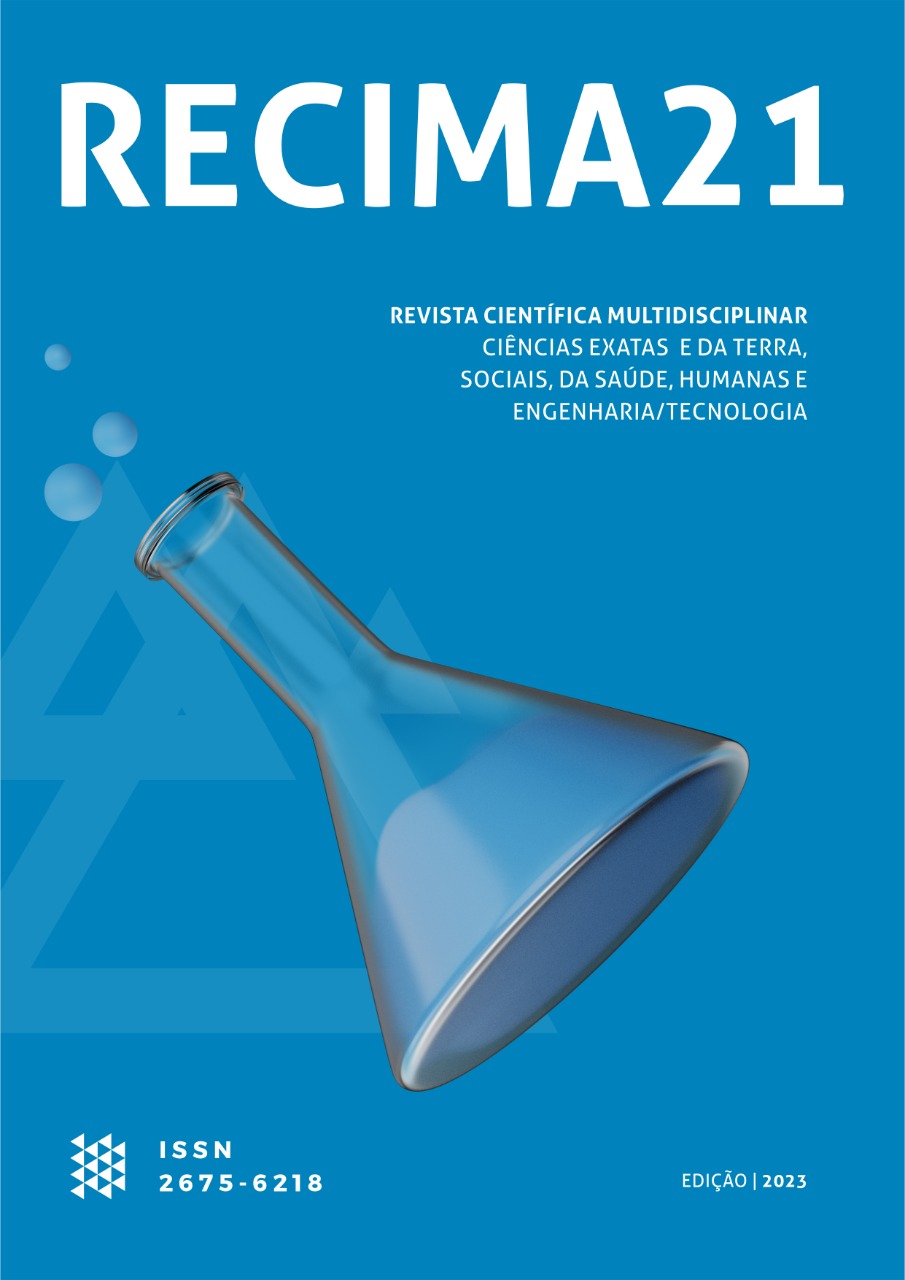EFEITOS DA POSIÇÃO PRONA NA SÍNDROME DA ANGÚSTIA RESPIRATÓRIA AGUDA (SARA/SDRA)
DOI:
https://doi.org/10.47820/recima21.v4i1.2523Palavras-chave:
posição prona, decúbito ventral, síndrome da angústia respiratória agudaResumo
Objetivo- Este estudo teve por objetivo analisar os efeitos da posição prona no tratamento da síndrome da angústia respiratória aguda (SARA/SDRA). Métodos– Foi realizado uma revisão sistemática da literatura baseada no método Prisma, com a coleta de estudos na Scientific Eletronic Library Online (SciELO) e no site National Center for Biotecnology Information (NCBI), na base de dados PubMed. Foram incluídos artigos relacionados aos efeitos da posição prona no tratamento da SARA em pacientes adultos que estavam em ventilação mecânica, publicados no período entre 2016 e 2022 e escritos nos idiomas inglês e português. Foram utilizadas as seguintes associações com os operadores booleanos: Prone Position* AND Acute Respiratory Distress Syndrome NOT COVID*. Resultados- Dentre os principais efeitos relacionados à posição prona, cita-se a melhora na relação PaO2/FiO2, redistribuição de maneira homogênea do volume corrente pelo pulmão, diminuição da hiperdistensão alveolar e o colapso pulmonar, com consequente aumento do recrutamento alveolar entre as diferentes áreas do pulmão. Sobre os protocolos, verificou-se diferença no tempo de pronação do paciente, que variou de 16 a 24 horas. Conclusão- A posição prona aplicada em pacientes com SARA/SDRA grave, mecanicamente ventilados, promove a melhora na relação PaO2/FiO2 e outros benefícios cardiopulmonares. Porém, torna-se necessário mais estudos para a padronização na aplicação da técnica.
Downloads
Referências
Sweeney R Mac, McAuley DF. Acute respiratory distress syndrome. Lancet. 2016;388(10058):2416–30.
Oliveira RHR, Basille A-F. Incidência de lesão pulmonar aguda e síndrome da angústia respiratória aguda no centro de tratamento intensivo de um hospital universitário: um estudo prospectivo. J. Bras. Pneumol. 2006;32(1):35–42.
Estenssoro E, Dubin A. Síndrome de Distrés Respiratorio Agudo. Medicina (B. Aires). 2016;76(4):235–41.
Ambrosino N, Makhabah DN. Comprehensive physiotherapy management in ARDS. Minerva Anestesiol. 2013;79(5):554–63.
Munshi L, Sorbo L Del, Adhikari NKJ, Hodgson CL, Wunsch H, Meade MO, et al. Prone position for acute respiratory distress syndrome: A systematic review and meta-analysis. Ann. Am. Thorac. Soc. 2017;14(4):280–88.
Paiva KC de A, Beppu OS. Posição prona. J. Bras. Pneumol. 2005;31(4):332–40.
Borges DL, Rapello GVG, Andrade FMD de. Posição prona no tratamento da insuficiência respiratória aguda. Assoc. Bras. Fisioter. Cardiorrespiratória e Fisioter. em Ter. Intensiva. 2020;s/v(s/n):1–7.
Barbas CSV, Ísola AM, Farias AM de C. Diretrizes Brasileiras de Ventilação Mecânica. 1a. São Paulo- SP: ed. AMIB e SBPT; 2013.
Hospital-Israelita AE. Diretrizes assistenciais Posição Prona na SDRA. Hosp. Isr. Albert Einstein. 2010;1–3.
Liberati A, Altman DG, Tetzlaff J, Mulrow C, Gøtzsche PC, Ioannidis JPA, et al. The PRISMA statement for reporting systematic reviews and meta-analyses of studies that evaluate health care interventions: Explanation and elaboration. PLoS Med. 2009;6(7):1–28.
Aguirre-Bermeo H, Turella M, Bitondo M, Grandjean J, Italiano S, Festa O, et al. Lung volumes and lung volume recruitment in ARDS: a comparison between supine and prone position. Ann. Intensive Care. 2018;8(1):1–9.
Dalla Corte F, Mauri T, Spinelli E, Lazzeri M, Turrini C, Albanese M, et al. Dynamic bedside assessment of the physiologic effects of prone position in acute respiratory distress syndrome patients by electrical impedance tomography. Minerva Anestesiol. 2020;86(10):1057–64.
Guérin C, Beuret P, Constantin JM, Bellani G, Garcia-Olivares P, Roca O, et al. A prospective international observational prevalence study on prone positioning of ARDS patients: the APRONET (ARDS Prone Position Network) study. Intensive Care Med. 2018;44(1):22–37.
Jochmans S, Mazerand S, Chelly J, Pourcine F, Sy O, Thieulot-Rolin N, et al. Duration of prone position sessions: a prospective cohort study. Ann. Intensive Care. 2020;10(1):1–9.
Kao KC, Chang KW, Chan MC, Liang SJ, Chien YC, Hu HC, et al. Predictors of survival in patients with influenza pneumonia-related severe acute respiratory distress syndrome treated with prone positioning. Ann. Intensive Care. 2018;8(1):1–9.
Khan F, Fistler CR, Mixell J, Caplan R, Vest MT. Community Experience With Acute Respiratory Distress Syndrome in the Prone Position. Crit. Care Explor. 2019;1(12):1–5.
Hadaya J, Benharash P. Prone Positioning forAcuteRespiratory Distress Syndrome(ARDS). J. Am. Med. Assoc. 2020;323(22):2329–30.
Gattinoni L, Taccone P, Carlesso E, Marini JJ. Prone Position in Acute Respiratory Distress Syndrome - Rationale, indications and limits. Am. J. Respir. Crit. Care Med. 2013;188(11):1286–93.
Gattinoni L, Busana M, Giosa L, Macrì MM, Quintel M. Prone Positioning in Acute Respiratory Distress Syndrome. Semin. Respir. Crit. Care Med. 2019;40(1):94–100.
Downloads
Publicado
Edição
Seção
Categorias
Licença
Copyright (c) 2023 RECIMA21 - Revista Científica Multidisciplinar - ISSN 2675-6218

Este trabalho está licenciado sob uma licença Creative Commons Attribution 4.0 International License.
Os direitos autorais dos artigos/resenhas/TCCs publicados pertecem à revista RECIMA21, e seguem o padrão Creative Commons (CC BY 4.0), permitindo a cópia ou reprodução, desde que cite a fonte e respeite os direitos dos autores e contenham menção aos mesmos nos créditos. Toda e qualquer obra publicada na revista, seu conteúdo é de responsabilidade dos autores, cabendo a RECIMA21 apenas ser o veículo de divulgação, seguindo os padrões nacionais e internacionais de publicação.













